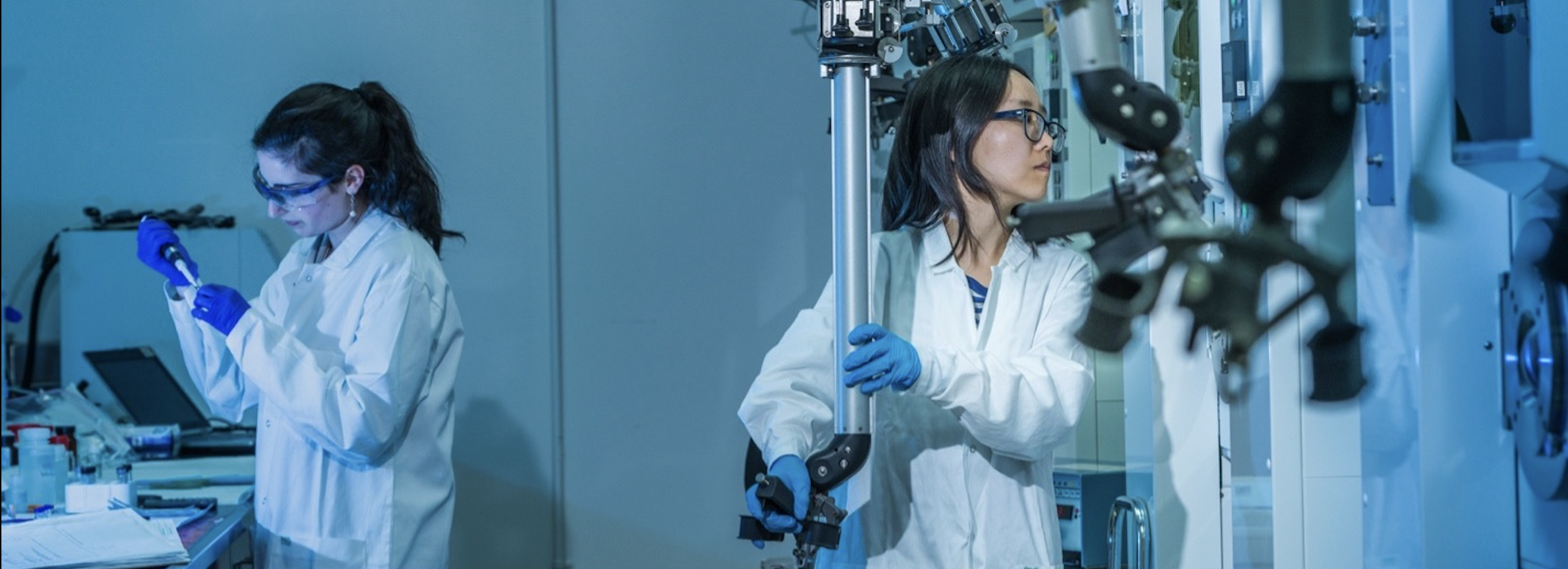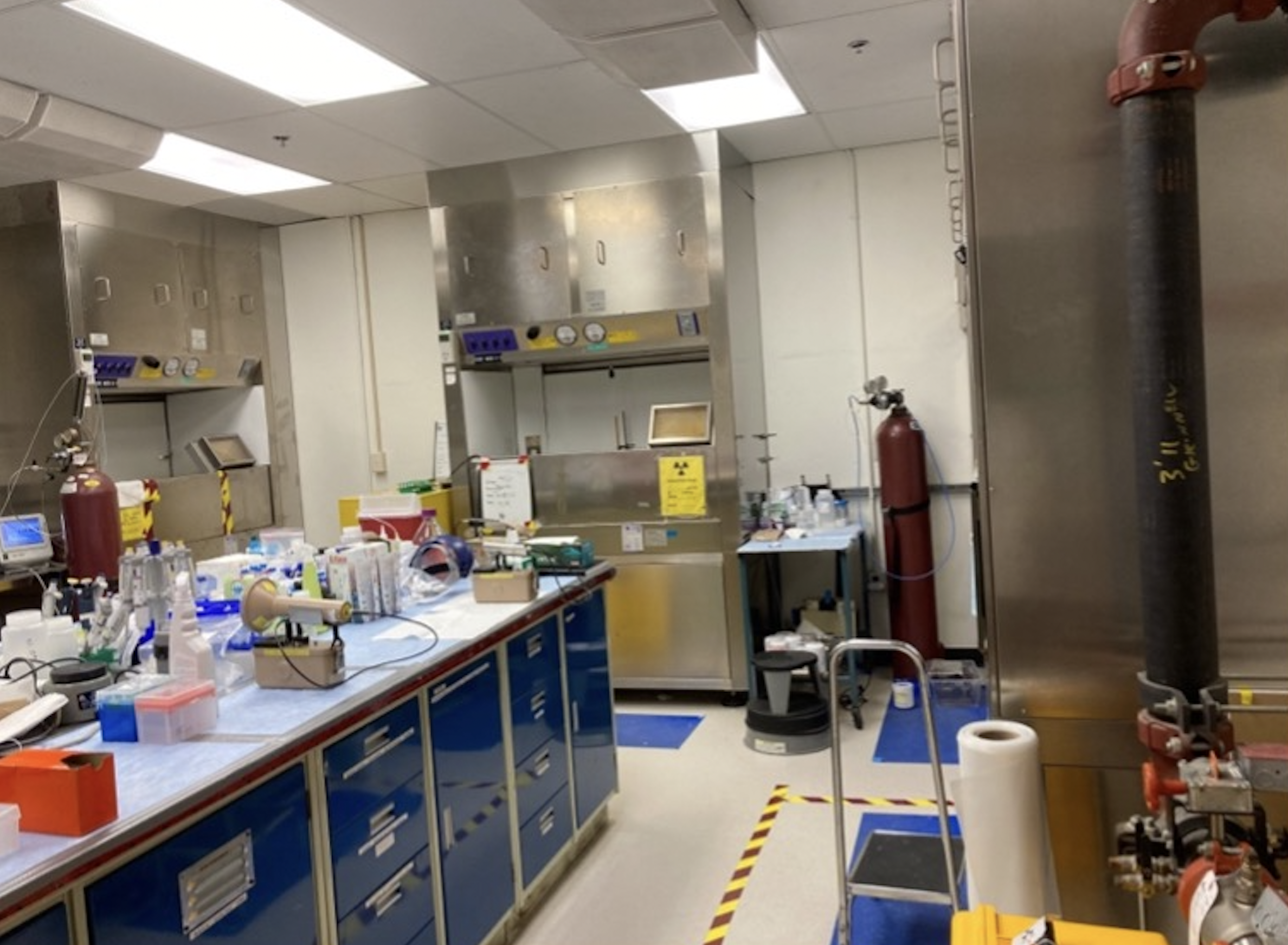OUR LABS
TRIUMF Life Sciences Research Labs
The Life Sciences Division has five research labs - Radiochemistry Research, Wet Chemistry, Target Design and Manufacturing, Radiobiology, and GMP Capable Radiopharmaceutical Production - that are for the development of radiopharmaceuticals used for medical imaging studies and therapy treatments for cancer. These tracers are synthesized and labeled with various radionuclides followed by in vitro and in vivo studies. The radionuclides are mainly produced on the TR-13 (13 MeV cyclotron) and the TRIUMF main cyclotron (500 MeV). Some radionuclides are also produced and obtained from commercial vendors (e.g. BWXT) and other external sources. Current radionuclides of interest are represented but not limited to Pd-103, Sb-119, Hg-197m/g, Pb-212/Bi-212, Ac-225, Th-227, U-230 for Targeted Radionuclide Therapy (TRT) and C-11, F-18, Sc-44, Cu-64, Ga-68, Zr-89, Tb-155, Pb-203 for diagnostic with PET or SPECT.
The Radiochemistry Research Labs are where the radionuclides are extracted and purified from the irradiated target material (e.g., Ca, Ba, Ag) and reacted with either a peptide or an antibody conjugated to a chelator to make tracers that can be used further for in vitro and in vivo studies. RCR-1 has four hot cells, which allows for high levels of radioactivity to be processed remotely with manipulators and automated synthesis modules while protecting the operator. Thorium targets that have been irradiated by the 500 MeV cyclotron, are dissolved and the Ac-225 is extracted through a number of chemical processing steps. RCR-1 also has some high-tech equipment, such as an ICP-MS and gamma spectrometer, which is used for radioactive elemental analysis. This helps the researcher determine radionuclidic and radiochemical purities.
RCR-2 has six lead shielded fume hoods that allow researchers to work with low levels of radioactivity to make tracers, which are composed of either a peptide or antibody conjugated to a chelator and then have an isotope (Zr-89, Tb-161, Ac-225 etc.) attached to it. These “tracers” can be used for medical imaging (e.g. PET Scan) to diagnose diseases such as cancer or to treat other diseases.
Radiochemistry Research Labs
RCR-1 (Hot Cell)
RCR-1 (ICP-MS)
RCR-2 (Researchers in the lab)
RCR-2 (Lead shielded fume hoods)
The synthesis of the various compounds (e.g., peptides and chelators) takes place in Lab 110 which has three fume hoods available for organic synthesis. There is a peptide synthesizer that facilitates the synthesis process by automation. There are also many pieces of equipment, such as an HPLC that assists in the purification of these compounds before they move to the Radiochemistry Labs.
Located on the ground floor of the Radiochemistry Annex is the GMP Quality Control Lab. Also known as Lab 103, it is home to a gas chromatograph, a radio-thin layer chromatography scanner, and quality control equipment used for the Life Sciences’ radiopharmaceutical production program. It also doubles as receiving, quarantine, and storage area for consumables used for radiopharmaceutical production.
Wet Chemistry Laboratories
HPLC (High Performance Liquid Chromatography)
Target Design and Manufacturing
Many different targets made from gold, calcium, barium, and other materials are designed and fabricated in the Target Design and Manufacturing lab. These targets are an essential component in the production of radionuclides by irradiation via the 500 MeV cyclotron (p,xn and spallation reactions) or the TR-13 (through p,n or p,2n reactions).
High temperature furnace for the fabrication of Targets
The Radiobiology Lab is our newest research space built for the purpose of expanding our work here at TRIUMF beyond the synthesis stage of radiopharmaceutical development. The lab is a fully functional tissue culture lab where novel radiopharmaceuticals (tracers) are evaluated from their initial design to receptor-binding assays. Further preclinical evaluation is done in collaboration with institutions such as BC Cancer and the Centre for Comparative Medicine.
Radiobiology Lab
Student working on tissue culture in the biological safety cabinet.
GMP Capable Radiopharmaceutical Production
Positron Emission Tomography (PET) is a functional nuclear medicine imaging technique that uses radiolabelled pharmaceuticals or radiotracers to visualize and measure disease-related changes to biological processes in the human body. Radiopharmaceuticals used in PET are radiolabelled or tagged with positron-emitting nuclides such as fluorine-18, carbon-11, nitrogen-13, oxygen-15, gallium-68, etc.
The Life Sciences Division’s facilities include two radiochemistry laboratories located in the basement of TRIUMF’s Radiochemistry Annex (RCA) building. RCA laboratories 005 and 007 are used for the development and production of radiopharmaceuticals used for preclinical and clinical PET research at UBC’s PET/MRI Imaging Center and at the BC Cancer Research Centre.
The radiopharmaceuticals developed and routinely produced in the two RCA labs utilize carbon-11 (C-11, 20-minute half-life) or fluorine-18 (F-18, 110-minute half-life). These PET radionuclides are produced via proton bombardment of cyclotron targets located at the nearby TR-13 accelerator facility. The irradiated target material containing C-11 or F-18 is transferred remotely through shielded capillary lines to Labs 005 and 007 for purification and incorporation into biologically relevant molecules. The molecules to be radiolabelled are selected by physicians and chemists depending on the ultimate purpose of the imaging. Most of the radiopharmaceuticals produced in these labs are used for brain imaging.
Both RCA labs have cleanroom areas with hot cells installed where the radiopharmaceuticals are produced following Good Manufacturing Practices (GMP) guidelines. Operators are specially trained for cleanroom access and must gown up before entering. The hot cells in the cleanrooms are needed to contain radioactive material and to shield the operators from radioactivity during radiopharmaceutical processing. Each hot cell houses an automated synthesis unit that allows remote automated production of the radiopharmaceuticals to minimize radiation exposure during production. The outer lab areas are used for material storage and are equipped with quality control equipment such as dose calibrators, bacterial endotoxin testers and HPLCs.
Lab 007 is equipped with a pneumatically operated pipeline or “rabbit” line with three lines from the Radiochemistry Annex to the Acute Care Unit at UBC hospital, the Vector Suite at the Centre for Comparative Medicine, and the Centre for Brain Health to deliver radiotracers.
Solution preparation by a chemist
Automatic Synthesis preparation









